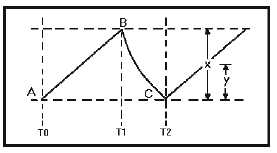28
3-40. Applying synchronizing triggers with a
frequency that is SLIGHTLY higher than
the free-running frequency will cause a
synchronized blocking oscillator to
1. divide in frequency
2. double in frequency
3. lock in at the higher frequency
4. stay locked at the free-running
frequency
Figure 3F.—Sawtooth waveform.
IN ANSWERING QUESTIONS 3-41
THROUGH 3-46, REFER TO FIGURE 3F
AND MATCH THE WAVEFORM POINTS
(OR TIME REFERENCES) TO THE TERMS
IN THE QUESTIONS. SOME CHOICES
MAY BE USED ONCE, MORE THAN ONCE,
OR NOT AT ALL.
3-41. Linear slope.
1. A to B
2. B to C
3. T0 to T2
4. T1 to T2
3-42. Physical length.
1. A to B
2. B to C
3. X
4. Y
3-43. Sweep time.
1. A to B
2. B to C
3. T0 to T1
4. T1 to T2
3-44. Fall time.
1. A to C
2. T0 to T1
3. T1 to T2
4. T0 to T2
3-45. Electrical length.
1. B to C
2. T0 to T1
3. T1 to T2
4. T0 to T2
3-46. Amplitude.
1. A to B
2. B to C
3. X
4. Y
3-47. The linearity of the rise voltage in a
sawtooth wave is determined by which of
the following circuit timing actions?
1. The time the capacitor is allowed to
charge
2. The time it takes the capacitor to fully
charge
3. The time the capacitor is allowed to
discharge
4. The time it takes the capacitor to fully
discharge

